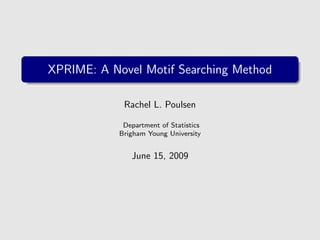
XPRIME: A Novel Motif Searching Method
- 1. XPRIME: A Novel Motif Searching Method Rachel L. Poulsen Department of Statistics Brigham Young University June 15, 2009
- 2. Introduction DNA contains the genetic instructions that uniquely define an organism RNA is created to carry genetic instructions from the DNA to the rest of the cell
- 3. Introduction DNA contains the genetic instructions that uniquely define an organism RNA is created to carry genetic instructions from the DNA to the rest of the cell The process of DNA “talking” to the rest of the cell is called transcription
- 4. Transcription DNA
- 5. Transcription DNA RNA
- 6. Transcription DNA RNA
- 7. Position Weight Matrix (PWM) (Hertz et al 1990)
- 8. Position Weight Matrix (PWM) (Hertz et al 1990) ETS1 TF binding motif Position: 1 2 3 4 5 6 7 8 A 0.067 0.333 0.0 0.0 1.0 0.533 0.267 0.067 C 0.933 0.600 0.0 0.0 0.0 0.133 0.067 0.400 G 0.000 0.000 1.0 1.0 0.0 0.000 0.667 0.000 T 0.000 0.067 0.0 0.0 0.0 0.333 0.000 0.533
- 9. Sequence Logos Figure: DNA binding motif for the ETS1 TF
- 10. De Novo motif searching
- 11. De Novo motif searching Regular expression enumeration
- 12. De Novo motif searching Regular expression enumeration 1 Actual count vs. expected count 2 Dictionary-based sequence model (Bussemaker et al. 2000)
- 13. De Novo motif searching Regular expression enumeration 1 Actual count vs. expected count 2 Dictionary-based sequence model (Bussemaker et al. 2000) PWM updating
- 14. De Novo motif searching Regular expression enumeration 1 Actual count vs. expected count 2 Dictionary-based sequence model (Bussemaker et al. 2000) PWM updating 1 MEME (Bailey et al 1995) 2 Gibbs Motif Sampler (GMS) (Lawrence et al 1993) 3 BioProspector (Liu et al 2001) 4 AlignACE (Roth et al 1998)
- 15. Known Motif Search 1 GREP 2 Database search with scoring function (Hertz et al 1990)
- 16. XPIME: An Improved Method
- 17. XPIME: An Improved Method TRANSFAC (Matys et al 2003) Information pulled from in vitro experiments and literature Most methods justify results using TRANSFAC
- 18. XPIME: An Improved Method TRANSFAC (Matys et al 2003) Information pulled from in vitro experiments and literature Most methods justify results using TRANSFAC XPRIME incorporates prior information
- 19. XPIME: An Improved Method TRANSFAC (Matys et al 2003) Information pulled from in vitro experiments and literature Most methods justify results using TRANSFAC XPRIME incorporates prior information XPRIME can search for both de novo motifs and known motifs simultaneously
- 21. Notation and Data Indices w: width of motif L: length of sequence m: motif indicator i: position in sequence j: position in motif s: indicates sequence
- 22. Notation and Data Indices w: width of motif L: length of sequence m: motif indicator i: position in sequence j: position in motif s: indicates sequence The data, zs
- 23. Notation and Data Indices w: width of motif L: length of sequence m: motif indicator i: position in sequence j: position in motif s: indicates sequence The data, zs zs = (yis , ∆1i , ∆2i , · · · , ∆(m+1)i ) yi represents the position (w-mer) ∆mi indicates if yi belongs to motif m or not ∆(m+1)i indicates if yi belongs to the backgrond motif or not
- 24. The Scoring Function w MotifScore = f (y) = pij I (yj = i). j=1 i∈A,C ,G ,T
- 25. Methods: Complete Data Likelihood (m+1) – component mixture model
- 26. Methods: Complete Data Likelihood (m+1) – component mixture model Ls L(θ|z) = C (yi )[r1 f1 (yi )]∆1i [r2 f2 (yi )]∆2i · · · [rm+1 fm+1 ]∆(m+1)i i=1 f(y) is the Motif Score equation
- 27. Methods: Priors fm+1 (y ) is fixed a priori ∆(m+1)i ’s are missing a priori f1 (y ), · · · , fm (y ) have product Dirichlet priors such that L ap mij −1 π(fm (y )) ∝ pmjk j=1 k∈(A,C ,G ,T ) r also has a Dirichlet prior M ari −1 π(r) ∝ ri i=1
- 29. Methods: Gibbs Algorithm 1 Draws ∆’s from a multinomial distribution p∆ ∝ rM ∗ fM (y )
- 30. Methods: Gibbs Algorithm 1 Draws ∆’s from a multinomial distribution p∆ ∝ rM ∗ fM (y ) 2 Draws r from a Dirichlet distribution L αr = i=1 ∆Mi + aM
- 31. Methods: Gibbs Algorithm 1 Draws ∆’s from a multinomial distribution p∆ ∝ rM ∗ fM (y ) 2 Draws r from a Dirichlet distribution L αr = i=1 ∆Mi + aM 3 Draws pmij from a Dirichlet distribution L αpmij = i=1 k={A,C ,G ,T } ∆mi I (yij = k) + apmij
- 32. An Example: ETS1 We hypothesize that ETS1 has a specific binding site The Data 1 ETS1 only 2 GABP only 3 ETS1 and GABP
- 33. ETS1 Binding Motifs (a) ETS1 from TRANSFAC (b) ETS1 from ETS1 only (c) ETS1 from GABP only (d) ETS1 from ETS1/GABP
- 34. Justification of Prior Information Pete Hollenhorst sequence logo
- 35. Justification of Prior Information Figure: Motif found without prior specification Figure: Motif found with prior specification
- 36. Conclusions and Future Research
- 37. Conclusions and Future Research XPRIME successfully searches for de novo and known motifs
- 38. Conclusions and Future Research XPRIME successfully searches for de novo and known motifs Evidence found suggesting ETS1 has its own binding motif
- 39. Conclusions and Future Research XPRIME successfully searches for de novo and known motifs Evidence found suggesting ETS1 has its own binding motif Hidden Markov Models and forward backward algorithm
- 40. Conclusions and Future Research XPRIME successfully searches for de novo and known motifs Evidence found suggesting ETS1 has its own binding motif Hidden Markov Models and forward backward algorithm Prior information on r